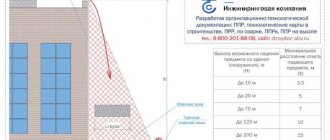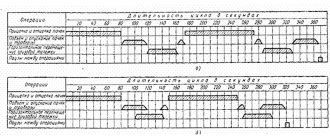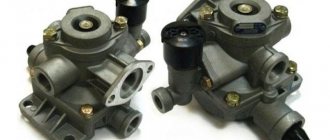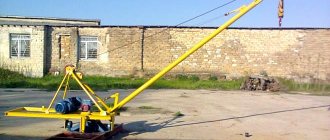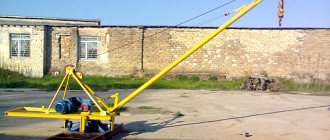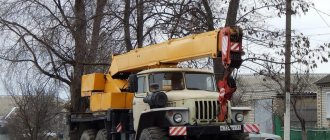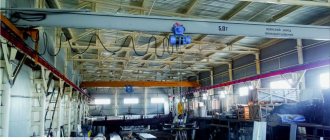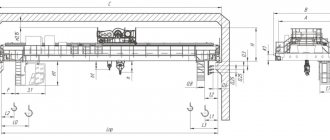During construction work on the site, breakdowns and accidents often occur, which can pose a danger to human life. That is why during construction it is very important to follow the rules of SNiP. If construction is carried out using a crane, then it is necessary to calculate in advance the so-called radius of the dangerous work zone. But what does this term mean? How to calculate this radius? And what do you need to remember when construction is carried out using a crane? Below we will find out the answers to these questions.
What is the radius of the crane's danger zone?
A dangerous work zone is the area around a construction crane, which can pose a threat to human life during construction (in the event of an emergency, if the holders break, and so on). This area can also pose a danger to other objects and buildings (utility rooms, various equipment, and so on). To calculate this zone, a special formula is used, and the resulting value is called the radius of the danger zone.
Using this radius, the engineer determines the circle that will be the danger zone. The boundary of the danger zone is taken into account during the construction and installation of a construction site, which may include warehouses, refueling and repair points, domestic buildings, and so on. According to SNiP standards, the boundaries of the dangerous zone must be fenced so that strangers do not accidentally cross it. Workers, in turn, are allowed to cross the border in certain cases, and before construction, workers must read the safety rules regarding working with the hazardous area of the crane.
Potentially unsafe areas
Areas that pose a potential threat are influenced by temporary factors. Therefore, more lenient requirements for installing fencing apply to them. Potential risk areas include:
- space near buildings and structures being erected (under construction);
- areas on the floors of buildings and structures in one occupation, over which construction and installation work is carried out;
- areas for vehicles and other movable equipment;
- areas over which cargo is moved using cranes.
This list also applies to the construction industry. In places with permanent and potentially dangerous production factors, temporary and permanent residence zones for the organization’s employees cannot be located.
How to calculate the radius?
There are several formulas that are used to calculate the radius of the danger zone of a crane. In practice, the following formula is usually used to calculate the radius of the danger zone: ROZ = C + 0.5 x G + O. This formula is deciphered in the following way:
- ROZ - radius of the danger zone. This is the parameter we want to get.
- C is the maximum reach of the crane boom. In the event of an emergency (for example, a malfunction of the control electronics), the crane boom can travel a maximum distance, so we need to take this parameter into account.
- G is the maximum dimensions of typical cargo. During construction, the crane will move weights, and the loads themselves in relation to the crane will extend beyond the maximum reach of the boom, so we need to take this “defect” into account. It should be noted that to transport the load, the crane will grab it approximately in the middle, so in the formula we must multiply this parameter G by a correction factor of 0.5.
- O is the maximum departure of the load. When moving, the load can accumulate potential energy, and in the event of an emergency disconnection (for example, the holders are broken), the load can suddenly fly away due to the transformation of potential energy into kinetic energy of movement. Parameter O is determined using special tables, and its value directly depends on the height of the crane boom.
| Boom height, m | 10 | 20 | 50 | 100 | 200 | 300 |
| Maximum departure value, m | 4 | 7 | 9 | 13 | 20 | 25 |
Kinds
Since a danger zone is a place where special safety regulations apply, you need to understand its types. The classification is based on factors affecting the safety of workers. They come in two types:
- permanent;
- potential.
This classification of factors was developed and established by the Ministry of Health of the Russian Federation. In addition, there is a list of GOSTs regulating the size and working conditions in unsafe working areas. The employer is responsible for their failure to comply.
Examples of danger zone calculations
To reinforce the material, consider a simple example:
- We have a construction crane whose boom will move at a height of 20 meters. The maximum reach of the crane boom is 50 meters. The main loads are concrete slabs, the length of which is 4 meters.
- Let's formalize the problem: parameter C will be equal to 50, parameter Г = 4 (in the formula we will also multiply this value by 0.5), and parameter O will be equal to 7 (information taken from the table).
- Now let's make the calculation: ROZ = C + 0.5 x G + O = 50 + 0.5 x 4 + 7 = 59 meters. This will be the radius of the danger zone.
The presented formula is typical, and it is suitable for all basic situations. If you have any doubts about the correctness of your own calculations, you can seek help from special companies that carry out such assessments of the operation of technical equipment on a professional basis.
Definition of the concept
Sites near:
- buildings under construction;
- operation of cranes, pipe layers;
- operation of excavators, dump trucks, asphalt pavers and other machines;
- pipeline testing;
- sudden changes in height - pits, trenches.
Danger zones when operating a jib crane
The perimeters of each area are designated separately, depending on the type of equipment being operated and the potential hazard factor.
This is interesting: The design and principle of operation of a pile driving installation
Tower cranes - why are accidents common?
Unlike other types of hoisting mechanisms, tower cranes are relatively prone to collapse. The reason for this is their design features. The track track along which it moves, as a rule, has a width (that is, the distance between the rails) of no more than six meters. The base of the crane (we are talking about the gap between the axes of its running trolleys, which are located on the same rail) is also insignificant and, as a rule, does not exceed the same distance.
Its height is quite high, and this makes the tower crane very sensitive to wind loads. The same applies to other conditions of its operation. If there are strong gusts of wind, the crane may fall even when not working. To prevent this, anti-theft grips are used.
Crane falls, which occur frequently, are largely unaffected by carefully observed safety regulations. Statistics have shown that this most often happens to those who use rail tracks for transportation.
Marking in warehouses
As mentioned earlier, a danger zone is a space where there is a real threat to the health and life of workers. Such areas exist at any production enterprise, regardless of its field of activity. Therefore, they must be protected not only at construction sites.
Warehouses are also places where workers can often be injured. Most often this is due to the instability of boxes, containers, and packages stored in specially designated areas. Of course, with proper loading and storage, the risk of injury in the warehouse is low. However, due to the carelessness or inattention of employees and people responsible for observing safety rules, workers may suffer irreparable harm to their health. Therefore, hazardous production zones in warehouses are marked with appropriate markings.
The marking process. Benefits of labeling
If the warehouse owner is a private individual, it is important that the entrepreneur follows the full technological process for designing and marking. If the production facility has a separate labor protection service, then this process falls under its direct responsibilities. It includes several steps:
- Determining the location and type of potential threat.
- Coordination of the project with authorized organizations.
- Installation of markings in accordance with current standards and GOSTs.
To accurately determine the location and type of potential danger, a company can turn to the services of professionals who will conduct a thorough audit of the premises, correctly assessing all possible risks. Without this, you cannot begin work in a dangerous area, otherwise if a warehouse worker is injured, its owner will not only suffer huge losses, but also risk being left without a license.
Advantages of marking:
- designation of all potentially hazardous areas;
- the ability to apply markings to highlight passages;
- safe organization of cargo movement within the warehouse;
- protection against collisions with motor vehicles.
Markings can be applied not only to indicate dangerous zones, but also to graphically highlight workplaces, pedestrian and vehicle paths, floor cargo storage cells and other things. A well-designed floor plan significantly reduces the risk of any traumatic situation occurring at work.
Necessary safety conditions
If unplanned work is carried out on a construction site, access to it should be carried out only with passes. A building that is constructed with the help of special equipment usually has doorways that lead to the area where the machines operate. When moving the slabs, they must be tightly closed.
Crane operators and all construction workers must be trained in how to move safely on a construction site. The crane operator must be able to calculate the working area and erect fences around it. Maintenance of equipment should be carried out only after construction has stopped.
